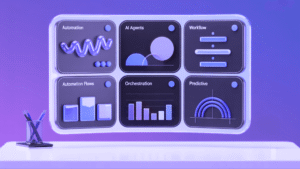Public Relations is an industry that never stands still. Trends shift, consumer habits evolve, and what’s popular today might be forgotten tomorrow. Yet, at its core, PR remains beautifully rooted in a human connection.
This guide explores where PR is today and offers practical insights to help you stay ahead as the industry continues to transform. Let’s dig in.
The role of AI in PR: A powerful ally
Artificial intelligence has transformed PR, reshaping how professionals engage with audiences, analyze data, and manage communications. It has enabled PR teams to transition from manual, time-intensive processes to streamlined, data-driven strategies. Think about that six-hour task you used to dread, now it’s potentially a 20-minute job with impressive precision. AI tools have become exceptional at:
- Drafting first drafts of press releases: AI can generate initial versions quickly, giving PR teams more time to refine messaging.
- Monitoring media mentions: AI-powered tools track mentions across platforms, offering real-time updates and sentiment analysis.
- Planning social content calendars: AI helps analyze trends to optimize timing and content strategy.
- Spotting patterns in media coverage: Advanced algorithms can uncover trends and insights that might go unnoticed.
However, AI isn’t without its limitations. There are critical areas where human expertise remains irreplaceable:
- Reading the room during a crisis: Understanding nuanced emotions and social cues remains a human strength.
- Building relationships with journalists: Genuine connections rely on trust and empathy.
- Understanding cultural nuances: AI may miss subtleties critical for authentic communication.
- Crafting an authentic brand voice: Human creativity and understanding are essential for consistency and relatability.
The key is not to fear AI but to embrace it wisely. As David Wharram, CEO of Elixirr Digital, notes: 72% of marketers are already using AI in their campaigns, but it’s not about replacement, it’s about augmentation. At the end of the day, AI is a powerful assistant, but it’s the human touch that makes the difference.
Measuring more than reach
Modern PR measurement looks into depth and complexity. It’s not always neat, it can be messy and complex, but when you get it right, the insights you uncover can show the real impact your efforts have on the business.
What’s making a difference now
Understanding how PR efforts are actually helping sales
It’s not just about how many people saw your campaign, did it actually lead to sales or other meaningful actions? Tools like Media Meter let you track press coverage and online mentions, and integrate that data with platforms like Salesforce, HubSpot, or Google Analytics. This connection moves you beyond basic metrics like impressions, giving you a clearer picture of how those mentions and posts translate into sales, leads, and other valuable outcomes.
For example, a feature in a top publication might bring traffic to your site. With these tools, you can track that traffic and see if it turns into inquiries or purchases.
Focusing on the quality of engagement, not just the numbers
Thousands of likes or comments might look impressive, but are they meaningful? Modern PR focuses on quality engagement: conversations that show real interest, sentiment, and intent to act. To achieve this, analyze the tone and content of responses, track actionable outcomes like clicks or shares, and craft messages that resonate deeply with your audience’s needs and values.
Tracing the customer journey to spot where PR makes a difference
In PR, we don’t just create awareness, we aim to influence decisions. Every touchpoint with your brand shapes a customer’s journey, from the moment they first hear about your product to their final purchase decision.
For example, a well-placed feature article in a trusted publication might spark initial interest, while positive user testimonials shared on social media could reinforce trust during the consideration phase. Pinpointing where your PR campaigns intersect with the customer journey allows you to understand exactly how and when your messaging is making an impact.
Measuring how your message lands compared to competitors
Knowing how your message compares to others in the industry is critical to understanding your impact. Start by monitoring share of voice (SOV)—how much of the media conversation your brand commands compared to competitors. Use tools like media monitoring and sentiment analysis to gauge how your key points resonate.
Are audiences responding positively? Are your messages driving more engagement than your competitors’? Analyze social media metrics, media mentions, and customer sentiment to pinpoint your strengths and identify gaps. This approach allows you to see if your PR efforts are not just keeping pace but helping you lead and shape the narrative in your industry.
ALSO READ: Catch the Buzz: 5 Reasons Why Media Monitoring Matters for Your Brand
Getting cultural authenticity right
Here’s a dilemma that keeps us up at night: Brands are struggling more than ever to connect authentically across different markets, and sometimes their well-meaning attempts at cultural sensitivity backfire spectacularly.
Recent lessons from the field
Bud Light’s partnership with a transgender influencer
Bud Light partnered with transgender influencer Dylan Mulvaney to promote inclusivity and representation. While the move was celebrated by progressive audiences, it sparked strong backlash from conservative customers who felt it didn’t align with the brand’s traditional image. The campaign quickly became a cultural flashpoint, leading to boycotts and a drop in sales that put Bud Light in the spotlight for all the wrong reasons.
Key takeaways:
- This shows how tricky it can be for brands to navigate socially charged topics. Inclusivity is important, but it’s just as critical to understand your audience and anticipate how different groups might react.
- Bud Light’s experience is a reminder to balance bold campaigns with thoughtful messaging that aligns with your brand identity.
- A clear strategy and preparation for potential backlash can help brands take a stand without losing the trust of their core audience.
Levi’s AI-generated model campaign
In an effort to promote diversity, Levi’s launched a campaign featuring AI-generated models. While the intention was to showcase inclusivity, it backfired as audiences criticized the use of artificial models in place of real representation. Many felt this was a cost-cutting move that undermined the authenticity of Levi’s message, sparking backlash and skepticism about the brand’s commitment to inclusivity.
Key takeaways:
- This highlights the limits of using technology for sensitive issues like diversity. Inclusivity can’t be simulated, it requires genuine effort and real representation to feel authentic.
- Levi’s experience serves as a reminder that human connection matters most when addressing social issues. Cutting corners might seem efficient, but it risks alienating audiences who value sincerity and meaningful action.
These cases show that cultural authenticity is non-negotiable in today’s PR world. The stakes are high, but getting it right builds trust, loyalty, and meaningful relationships with audiences.
Crisis management 2.0
Crises today unfold at lightning speed, spreading faster than your morning coffee cools down. Social media, viral trends, and instant global communication have made it nearly impossible to contain or slow down a developing issue.
The good news? While the challenges are bigger, the tools and strategies have also evolved to help brands navigate these turbulent waters.
What’s working now:
- Have message templates ready: Don’t wait until a crisis hits to figure out what to say. Pre-approved templates help you respond quickly and consistently. They’re flexible enough to fit different platforms, ensuring your message is clear and effective when time is of the essence.
- Monitor in real-time: Crises can start anywhere, from news outlets to social media and even private messaging apps. Keeping an eye on all these channels, including “dark social” spaces, gives you a full picture of what’s happening and helps you decide your next steps.
- Practice with crisis drills: Don’t just plan, test your response strategies regularly. Make sure your team is prepared to handle issues on platforms like TikTok, Instagram Reels, and whatever comes next. Preparation helps you stay calm and confident in real situations.
- Building goodwill early: The best crisis management happens before the crisis. A strong, trusted reputation cushions the blow and speeds recovery.
ALSO READ: Crisis Management 101: How to Manage a Business in Crisis
Bottom line
PR isn’t getting any simpler, but that’s okay. Instead of trying to predict the future, focus on building strategies that can roll with the punches. Keep it real, keep it relevant, and most importantly, keep it human.
Want to stay ahead of the curve? Check out Media Meter’s media monitoring services to keep your finger on the pulse. Contact us today, or check out our sample reports for a closer look.
-
Richelle is a writer, researcher, and a content marketing specialist at Media Meter Inc., turning complex media data into compelling narratives. With a background in research and data analytics, she combines attention to detail with a strategic approach to create content that resonates and drives results, helping brands forge meaningful connections with their audiences.
View all posts




